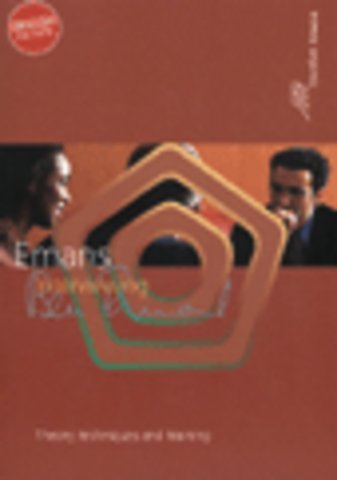

Dr. B.J.M. Emans is universitair hoofddocent Organisatiekunde aan de Rijksuniversiteit Groningen.
Meer over B.J.M. EmansInterviewing
Theory, techniques and training
Ingenaaid Engels 2004 1e druk 9789020732801Samenvatting
Interviewen is niet moeilijk. Goed interviewen is dat wel. Het vereist vakkennis en communicatieve competentie en er komt veel voorbereidend werk bij kijken. Interviewen - theorie, techniek en training ontvouwt de vakkennis waar het om gaat, biedt materiaal voor het trainen van een scala aan communicatieve vaardigheden en presenteert een beproefde systematiek van interviewvoorbereiding.
Zoals te verwachten was, heeft het computerondersteund interviewen een hoge vlucht genomen. Verder heeft er veel behartenswaardig onderzoek plaatsgevonden naar de communicatieprocessen die zich in interviewsituaties afspelen. De auteur heeft de laatste ontwikkelingen en inzichten verwerkt in dit boek.
Specificaties
Lezersrecensies
Inhoudsopgave
Introduction
Part 1: Orientation
Chapter 1 Interview characteristics
1.1 The purpose of interviewing: a moderate objectivist view
1.2 Objectivity
1.3 The interview guide
1.4 The neutral attitude of interviewers
1.5 Presence of third parties: yes or no
1.6 Anonymity: yes or no
1.7 Audio recording: yes or no
1.8 Informants and respondents
1.9 Interviews and self-administered questionnaires compared
1.10 Topics for discussion
Chapter 2 Telephone and computer-assisted interviewing
2.1 Telephone and face-to-face interviewing compared: answer quality
2.2 Telephone and face-to-face interviewing compared: possibilities and limitations
2.3 Computer-assisted interviewing
2.4 Technical interview types: an overview
2.5 Topics for discussion
Part 2: Conducting the interview
Chapter 3 Interviewer tasks
3.1 Combining and coordinating interviewer tasks
3.2 An illustration
3.3 Topics for discussion
3.4 Crucial error and rule for avoiding it
Chapter 4 Introducing the interview
4.1 The purpose of introducing interviews
4.2 The content included in introductions to interviews
4.3 An illustration
4.4 Getting permission to conduct the interview
4.5 More introductory activities
4.6 Topics for discussion
4.7 Crucial error and rule for avoiding it
Chapter 5 Asking questions
5.1 Opening question, evaluation, probing
5.2 The basic rule for asking questions
5.3 Literally, but not too literally
5.4 Paralinguistic features
5.5 Other non-verbal aspects
5.6 Introducing a question
5.7 Asking questions in a non-leading way
5.8 Asking understandable questions
5.9 How to deal with retrospective questions
5.10 Topics for discussion
5.11 Crucial mistake and rule for avoiding it
Chapter 6 Evaluating and probing
6.1 Evaluating answers
6.1 Probing
6.3 Topics for discussion
6.4 Crucial error and rule for avoiding it
Chapter 7 Leading the interview
7.1 Leading the interview: two components
7.2 Task-oriented interview leadership
7.3 Social-emotional interview leadership
7.4 Topics for discussion
7.5 Crucial mistake and rule for avoiding it
Part 3: Preparing the interview
Chapter 8 Designing the interview guide
8.1 The interview guide: its contents and functions
8.2 Step 1: defining the information need/ defining conceptual variables
8.3 Steps 2 and 3: from conceptual variables to indicator and raw variables
8.4 Step 4: from the purpose of the interview to more raw variables
8.5 Step 5: from raw variables to formats for answering and note-taking
8.6 Step 6: instructions for asking the questions
8.7 Step 7: ordering the questions
8.8 Step 8: adding the introduction, conclusion and lay-out
8.9 Step 9: testing the first draft of the interview guide
8.10 Computer-assisted interview guide design
8.11 Topics for discussion.
8.12 Crucial mistake and rule for avoiding it
8.13 Appendix: completed interview guide
Chapter 9 Interview training
9.1 Written exercises
9.2 Role-playing
9.3 Real-life exercises
9.4 Conclusion
Glossary
Notes
Appendices
Index
Anderen die dit boek kochten, kochten ook
Rubrieken
- advisering
- algemeen management
- coaching en trainen
- communicatie en media
- economie
- financieel management
- inkoop en logistiek
- internet en social media
- it-management / ict
- juridisch
- leiderschap
- marketing
- mens en maatschappij
- non-profit
- ondernemen
- organisatiekunde
- personal finance
- personeelsmanagement
- persoonlijke effectiviteit
- projectmanagement
- psychologie
- reclame en verkoop
- strategisch management
- verandermanagement
- werk en loopbaan





